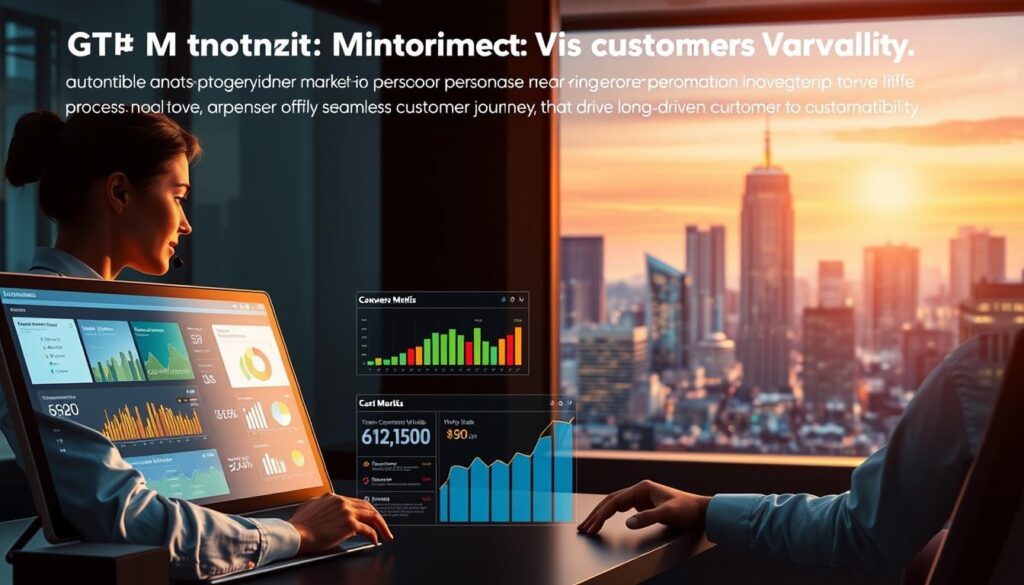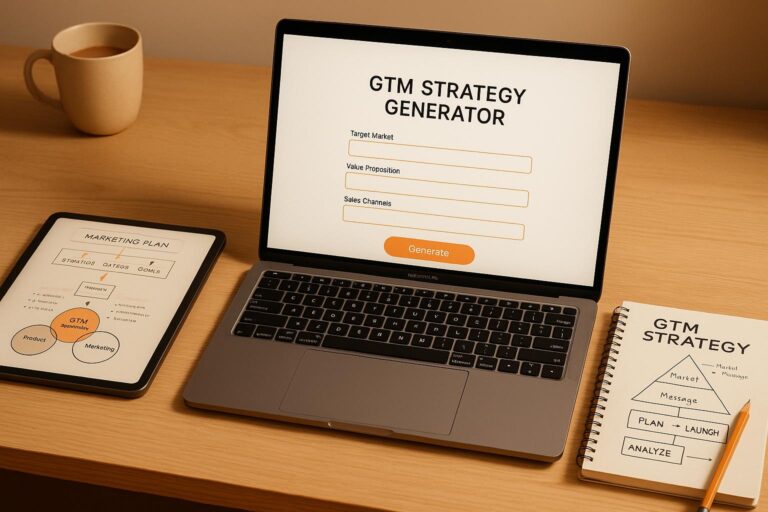In the world of business, making sure customers keep coming back is key. Using GTM automation to boost customer value isn’t just a passing trend. It’s vital for companies wanting to keep their customers and get better at marketing.
GTM automation makes things smoother, helping create stronger bonds with customers. It connects the dots across digital platforms for better customer talks. Since most customers stick around when they feel valued, using GTM automation is a smart move. It helps businesses grow and increases the value customers bring over time.
Key Takeaways
- Understanding the significance of customer lifetime value is crucial for business success.
- GTM automation enhances customer engagement and improves retention rates.
- Effective automation can significantly streamline customer interactions.
- Businesses that harness automation can tap into valuable customer insights.
- Clear objectives and proper tool selection are essential for successful GTM strategies.
Understanding Customer Lifetime Value (CLV)
Customer Lifetime Value (CLV) is key for businesses looking to grow. It tells how much money a company can expect from a customer while they’re connected. Knowing the value of CLV helps firms aim higher, using their resources wisely for the best returns.
Definition and Importance of CLV
CLV isn’t just about the short-term gains; it reflects the long-term profit from customers. With CLV, companies spot and keep valuable customers. This makes the business more profitable in the end.
Key Metrics for Measuring CLV
To really understand CLV, businesses should track key metrics such as:
- Purchase Frequency
- Average Order Value
- Retention Rate
These metrics shed light on customer habits. They help in finding ways to make the customer relationship stronger and more profitable.
Factors Influencing CLV
Several things can affect CLV, like:
- Product Quality
- Customer Service Experience
- Market Conditions
Knowing these factors helps businesses improve how they interact with customers. This is crucial for keeping customers and building long-term connections.
The Role of GTM Automation in Enhancing CLV
GTM automation helps businesses improve how they interact with customers. This leads to customers staying longer and being more loyal. Both are key to making the most out of customer lifetime value through GTM automation.
Streamlining Customer Interactions
Automated messages, chatbots, and targeted emails make talking to customers easier and more timely. These tools not only make the customer experience better. They also let businesses adjust their services using customer feedback and data.
Automating Data Collection and Analysis
Collecting and analyzing data automatically is key for making strategies based on data. With GTM automation, companies can learn what customers like and how they behave more efficiently. This information helps spot who might leave and allows for quick action to keep them. Easy access to detailed data lets companies find chances to sell more and offer personalized things that customers will like.

| Strategy | Benefit |
|---|---|
| Automated Messaging | Improved Response Times |
| Data Analytics Tools | Better Customer Insights |
| Personalization Algorithms | Higher Engagement Rates |
| Feedback Automation | Continuous Improvement |
Benefits of GTM Automation for CLV
GTM automation greatly boosts customer lifetime value. It lets businesses get deep insights on customers and personalize better. This makes the customer’s journey with a brand better. With good data analysis, firms see what keeps customers coming back. This leads to smarter choices.
Improved Customer Insights
GTM automation helps gather important info on what customers like and how happy they are. This method is better than old ways. It lets companies know what customers think at different points. They can then use tools to make sense of this data. This turns data into real steps to better customer bonds.
Enhanced Personalization Strategies
With good data, firms can make marketing really speak to each customer. Analyzing customer data well makes personalization possible. Messages made just for them make customers stay loyal. They’ll want to buy more. This smart plan greatly lifts customer lifetime value. It shows how powerful automation can be.
Implementing GTM Automation Strategies
Implementing effective GTM strategies for CLV starts with picking and integrating the right automation tools. This choice lays the groundwork for getting valuable customer insights and boosting engagement. By using the correct tools, organizations can fine-tune their strategies, making their processes more streamlined and efficient.
Choosing the Right GTM Tools
Choosing the best GTM tools means evaluating features that fit your business needs. It’s important to select platforms that grow with your company. They should be easy to use, provide detailed reports, and work well with other marketing systems. Top choices like Google Tag Manager and Optimizely are great for achieving these goals.
Integration with Existing Systems
It’s essential to integrate GTM tools with systems you already use to keep your data consistent. This ensures smooth data flow between GTM tools and your CRM or analytics platforms. Such integration not only makes operations smoother but also helps create detailed customer profiles for better marketing.
Defining Clear Objectives
Setting clear goals is crucial for GTM automation. You might want to focus on keeping customers longer or sending more personalized messages. Having specific targets helps steer the automation, allowing for measurement and needed tweaks. Clearly defined goals make sure automation aligns with what your customers need, boosting their lifetime value.
Best Practices for Maximizing CLV with Automation
Effective strategies can boost customer lifetime value (CLV). Automation helps streamline this through audience segmentation and A/B testing. It strengthens customer engagement and makes marketing efforts better.
Segmenting Your Audience Effectively
Tailoring messages to specific groups improves business. Companies categorize customers by behavior, preferences, and spending patterns to create relevant content. Automation makes grouping customers easy and helps launch campaigns that hit the mark with each segment.
A/B Testing Automation Campaigns
A/B testing is key for measuring different marketing tactics. It lets teams find out which methods engage customers the most. By constantly testing and adjusting based on data, businesses improve their marketing. This helps them greatly increase their CLV.
Overcoming Challenges in GTM Automation
Implementing GTM automation can be tough for organizations wanting to improve customer relations and make operations smoother. It’s key to beat these hurdles in GTM automation to create good strategies. These help build customer loyalty and trust.
Common Pitfalls to Avoid
Many firms face a few usual issues with GTM automation integration. Using wrong data can mess up marketing efforts a lot. Not linking different tools well can lead to work silos, making things less efficient. If team members aren’t trained well, they might not use the system right, affecting its rollout.
Ensuring Data Privacy Compliance
Data privacy is a big deal in GTM automation. Companies must follow rules like GDPR to keep customer info safe. If they don’t, they could face legal problems and hurt their reputation. To deal with GTM automation challenges, creating strong data privacy processes is crucial. This builds consumer trust and long-lasting relationships.

To get better at handling these issues, firms can look into effective automation strategies. Taking steps early to fix common problems can help GTM automation solutions succeed more.
Measuring Success: Key Performance Indicators (KPIs)
It’s vital to create effective KPIs for CLV when evaluating GTM automation efforts. These metrics should give insights into customer behavior and engagement. They help us understand how well we’re doing and where we can get better.
Identifying Relevant KPIs
To track GTM automation success, certain KPIs stand out, including:
- Customer Acquisition Cost (CAC): Shows the expense needed to get a new customer.
- Churn Rate: Indicates the fraction of customers lost, highlighting the importance of keeping them.
- Customer Retention Rate: Captures how well a business keeps its customers happy and loyal.
By closely watching these KPIs for CLV, businesses can make smart decisions. This can lead to a higher return on their investments by using these insights well.
Analyzing Results to Drive Improvement
Success in GTM automation depends on analyzing KPI outcomes. Understanding these numbers can show which strategies work best. Noticing trends helps businesses spot areas for improvement, enhancing their strategies.
For tips on boosting customer engagement and retention with automation, see this resource.
Keeping an eye on these indicators is key to raising customer lifetime value. It creates a feedback loop that leads to continuous success.
Future Trends in GTM Automation and CLV
The future of GTM automation looks exciting as new technologies come into play. One trend is using predictive analytics to keep customers. This is key for businesses wanting to boost their customer loyalty and lifetime value.
By understanding what customers might do next, companies can act early. This helps keep customers coming back. Understanding these patterns is essential for businesses aiming to increase customer loyalty.
Predictive Analytics in Customer Retention
Predictive analytics helps firms understand customer data and spot trends. This lets marketers adapt their strategies to keep customers. It’s a way to ensure customers stay loyal and support their value over time.
By focusing on important behaviors, businesses can keep and attract customers. This is part of optimizing customer lifetime value. Using analytics well is crucial in this process.
Innovations in Automated Marketing Technologies
Alongside predictive analytics, automated marketing technologies are changing customer interaction. With better tools for targeting and personalization, messages reach the right people at the right time. Companies using these tools can develop stronger customer ties.
Keeping up with these trends is important for a business’s success. Those looking for a competitive advantage should keep an eye on these developments. For more on customer retention, see customer retention metrics.
FAQ
What is the significance of driving customer lifetime value (CLV) through GTM automation?
Boosting CLV with GTM automation is vital as it helps keep customers, makes marketing better, and grows revenue. It lets businesses create stronger bonds with customers, which builds loyalty and boosts profits.
How can businesses effectively measure customer lifetime value (CLV)?
To measure CLV, companies look at how often people buy, how much they spend, and how long they stay. This helps them use their money wisely and focus on the most valuable customers to improve CLV.
What are some effective GTM automation strategies for optimizing CLV?
Good GTM automation strategies include automating how you gather and analyze customer data and using tools for mapping customer journeys. They also involve segmenting audiences for customized messages and creating personalized marketing that speaks to what people like.
What role does audience segmentation play in maximizing CLV?
Segmenting your audience lets you tailor your marketing for different groups. With automation, you can sort customers by their actions and likes, which makes them more engaged. This leads to keeping customers longer and increasing CLV.
How can predictive analytics benefit GTM automation strategies?
Predictive analytics lets businesses guess how customers will act, helping them keep customers before they leave. It makes GTM automation better by spotting risks of losing customers and finding chances to sell more, raising CLV.
What are some common challenges in implementing GTM automation?
Some hurdles include teams not working well together, using wrong data, and not connecting tools correctly. Also, keeping customer data safe and following laws is crucial to keep their trust and avoid legal problems.
What key performance indicators (KPIs) should businesses track for GTM automation?
Key metrics to watch include the cost to get customers, how many leave, and how many stay. Checking these regularly helps businesses find ways to get better and grow CLV.
What are best practices for ensuring data privacy compliance in GTM automation?
For data privacy, follow laws like GDPR, protect data well, and check how you handle data often. It’s also key to teach your team about data privacy rules to keep customer trust.
How can companies create an efficient feedback loop with GTM automation?
By using automation to collect feedback from many places and tools to analyze the data, companies get timely insights. This helps them continuously improve and increase CLV.



